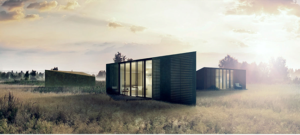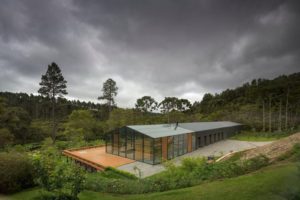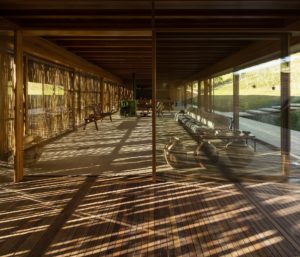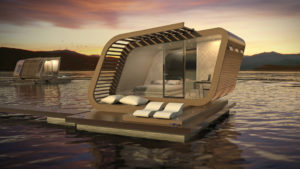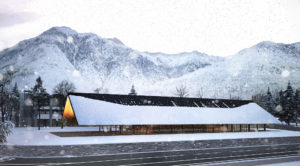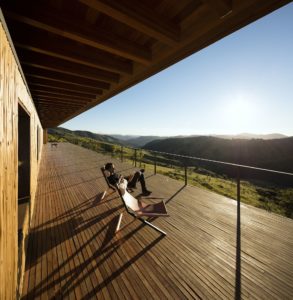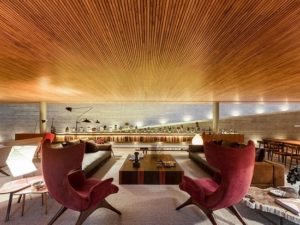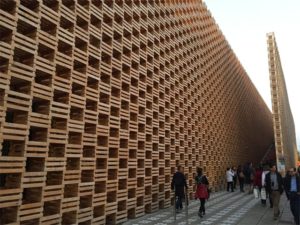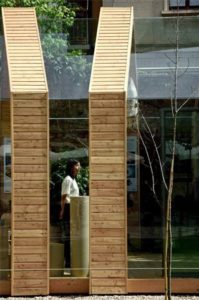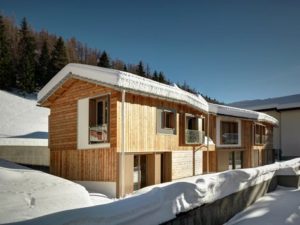Progetto ANK
team di progetto – Andrea Battistin, Andrea De Faveri, Manuel Marchesin, Mauro Striuli, Giacomo Bianco
committente – S-Unit
superficie 30 mq ca
calendario – 2013 progetto
Il progetto di minihouse ha da sempre esercitato le doti compositive dei più esperti architetti. Incastrare sapientemente in un piccolo spazio le molteplici funzioni dell’abitazione, senza rinunciare al confort dello spazio è la vera sfida che S-Unit ha provato a vincere. Le S-Unit sono case. Unità abitative mobili dalle geometrie essenziali e finiture personalizzabili, in rapporto diretto e simbiotico con l’ambiente esterno. Pensate per sentirsi sempre a casa, anche in vacanza. Un progetto su tre modelli di case prefabbricate in legno dalle elevate prestazioni energetiche, modulari tra loro e modulabili al loro interno, finalizzate al mercato turistico che richiede oramai standard abitativi sempre più prossimi a quelli alberghieri e flessibilità nel medio periodo.
The Mororó House is in a mountainous region, 180 km from the city of São Paulo, known for its low temperatures. The architecture sought to create generous internal spaces for the cold days, such as, for example, a cozy living room and an enclosed bathhouse with a pool, where the views can be appreciated while being protected by a skin of glass.
Externally, the same continuous volume creates a duality between an opaque block – where the living room, bedrooms and service areas are – and the transparent stretch of the heated pool and sauna. The volumetry of the house was given by a sixty-five meters extrusion of an icon-house, with pitched roof. Furthermore, an external wooden deck connects the spaces and creates a solarium to be used during the summer months.
In the opaque part of the volume, which is 50m long, the openings were minimized and used as sliding doors to intensify the integration between inside and out. This relation between empty and full in the façade allows for an excellent thermal performance, with a high degree of electric energy conservation. The transparent stretch is fourteen meters long and the internal ventilation was spatially designed to avoid condensation on the glass by the heated pool, which would harm the relation with the view.
The house was not situated on the top of a rugged site, as initially desired by the clients, but in its lowest part – in the midst of a beautiful forest of pine trees. This solution allowed the building to be surrounded by nature, creating an intimate relation with the site.
The initial premise of the project was to have a quick and cheap construction. Therefore, the architecture found industrialized solutions such as metal structures and steelframe walls. The site, despite high rainfall, remained always clean. Unlike the Brazilian constructive culture, few elements were made entirely on site, but instead mounted or assembled there. The time to build this house was less than the usual, even with the site’s difficult access.
The choice of the materials for the interiors, such as wood, made it a cozy house, like the traditional chalets in the mountains. Following the desires of the future residents, the kitchen could be integrated to the spaces via wooden sliding doors – that could be entirely opened. Thus, it was not only possible to design ample and continuous spaces on the inside, but also to have central spaces for the quotidian life which organized the house plan.
Laid out over the valley, at an altitude of 1,500 meters, the house has a strong relationship with the local nature, abundant throughout most of the year. That allow for autonomy in generating energy. The main premise of the project is to make energy consumption efficient while simultaneously offer comfort to the user, beginning with the simplicity of contact with the local nature.
It’s FSC wooden pre-fab structure, to the point that it remains supported on the land through some pillars, without directly touching the ground, responds well to the necessity of building on a rugged piece of land, far from the city and difficult access. On this, the external ground is a deck also made in certified wood and the internal floor is clay brick made from the local soil. From this same soil the house is made. The divisors of the house are wood frames with woolen insulation of PET which makes it an environmentally correct house. Frames with double windows guarantee the comfort and ventilation. The roof is a wooden platform with vegetation which integrates the house with its surroundings rue composing the area of the land shaded by it. In the vast landscape, the house create a link between that which is built and that which is natural.
The IRIDE 01 Floating Suite was designed to accommodate a comfortable en suite bedroom in 25 square metres. It is suitable for sheltered bays, tourist ports, marine parks, and lakes and it was designed as an annex for lakeside or riverside hotels to offer their guests a unique experience, as an alternative to the traditional accommodation.
Outdoor spaces and wide windows allow for contact with the environment outside, making it possible to appreciate the landscape to the full and enjoy a holiday with high standards of comfort in close contact with nature.
During the day the relationship between inside and outside may be adjusted to pleasure by means of special electronic window opacifiers.
The wooden modular structure on a floating pontoon of about 40 square metres, can vary in length, making it easy to assemble and disassemble, and at the same time limiting costs.
The pontoon consists of a few discontinuous floating units in reinforced concrete with an expanded polystyrene core and it is anchored to the seabed by ground anchors and flexible ropes, the most environmentally-friendly system available as the impact on the seabed is minimal.
The IRIDE 01 Floating Suite, designed for the French company H2orizon, can be purchased singly but it is also the ideal solution for a floating village, where some units can be grouped together and connected to the main building by floating walkways.
Il progetto di riqualificazione della Latteria Sociale Valtellina è l’occasione per restituire una nuova immagine affine all’identità della realtà che contiene e rappresenta, un luogo che ricorda il legame con la tradizione locale e la storia. Il progetto propone una reinterpretazione della malga – la tipologia di costruzione appartenente alla tradizione alpina – con il suo sviluppo in lunghezza, una copertura leggera, un volume su un unico piano, al cui interno trovano spazio i luoghi di vendita, esposizione e lavoro. Un modello che conduce al concetto di tradizione e qualità, il grande tetto si estende per coprire le aree esterne e le rende una naturale prosecuzione degli spazi interni, crea una piazza coperta lasciando intravedere ai passanti ciò che accade all’interno, invitando alla sosta e alla visita.
Concorso a inviti, 1° premio
Postalesio (SO), Italia
2016 – In corso
Committente: Latteria Sociale Valtellina S.C.A.
Superficie costruita: 1.000 mq
Laid out over the valley, at an altitude of 1,500 meters, the house has a strong relationship with the local nature, abundant throughout most of the year. That allow for autonomy in generating energy. The main premise of the project is to make energy consumption efficient while simultaneously offer comfort to the user, beginning with the simplicity of contact with the local nature.
It’s FSC wooden pre-fab structure, to the point that it remains supported on the land through some pillars, without directly touching the ground, responds well to the necessity of building on a rugged piece of land, far from the city and difficult access. On this, the external ground is a deck also made in certified wood and the internal floor is clay brick made from the local soil. From this same soil the house is made.
The divisors of the house are wood frames with woolen insulation of PET which makes it an environmentally correct house. Frames with double windows guarantee the comfort and ventilation. The roof is a wooden platform with vegetation which integrates the house with its surroundings rue composing the area of the land shaded by it. In the vast landscape, the house create a link between that which is built and that which is natural.
This project has received a Platinum Certification by the Green Building Council Brazil, the highest level possible. This is the first Brazilian project to receive such high-level certification.
All the furniture was provided by Prototyp& (prototypesp.com.br)
An important collection of African art rests on the wooden sideboard in the living room of Ramp House, located in a quiet garden-neighbourhood in São Paulo. The owners intend to convert the place in a cultural foundation in the future, thus the antique pieces, collected over the last decades, have determined the architectural design approach for the house: the use of the social spaces reveal the African masks in a delicate exhibition experience, in which art blends with everyday objects and domestic life merges with the historical pieces without the feeling of living in a museum.
A 25.50 meters long ramp – which connects the living room on the ground floor with the bedrooms on the first floor, where are also located the small home offices – organizes the internal architectural promenade and allows for observing the spaces from different perspectives. This movement between floors is made smoothly, as an interlude between the collective and the intimate areas.
The architecture of the Ramp House promotes a radical spatial continuity between the interior and exterior not only through large panes of sliding glass doors – that can be fully opened, connecting the living room with the garden – but also through the consistency in the use of the same materials both inside and outside. The wooden facade folds back towards the interior, becoming the roof liner that, in turn, folds again at the hall by the ramp to create an inner facade.
This three-dimensional surface building, a wooden ribbon, determines the structure and the actual volume of the house: a box – made of local Brazilian timber – projecting itself outward from the dense raw concrete sidewalls. Pillars rationally distributed over the internal space complete the structural system and contribute to enable the large spans of up to 9.70 meters. Setting up the ramp’s background – and of the whole living room – another concrete wall creates an austere, minimalist environment made with raw and natural materials. The timber on the roof lining also helps to complete the spatial feeling of cosiness in the room.
The 4 meter-wide veranda – facing the garden, under the cantilever– works as a gradation between exterior and interior, and constitutes a covered but open living space, pleasant to be used in hot days. This solution dialogues with the tradition of Brazilian architecture, both colonial and modern, which used historically analogous spaces for spatial transitions.
The relationship with the Brazilian architectural culture is also present in the folding wooden panels on the facade. Made of small brises-soleil (2cm wide and 7mm spacing), these elements allow for the shading of the bedrooms, with continued air circulation. The resulting is thermally pleasant internal spaces throughout the year.
The decor and interior design was conceived as a fundamental part of the architecture. The piece of furniture that holds the African masks in the living room, for example, had to have its own specific structural design to enable it to have the same clear span as the pillars (9,70m). The chairs, armchairs and tables mix old and new pieces by local Brazilian designers – such as Joaquim Tenreiro, Sergio Rodrigues – as well as international ones – such as Vladimir Kagan and George Nakashima – in order to highlight the architecture of the house and the artwork.
Ramp House’s project favoured the spatial continuity between inside and outside, the precise use of natural and raw materials and, above all, the possibility to exhibit in a delicate way the beautiful art collection as true architectural elements that organize the promenades. The spaces – free and continuous – can easily be rearranged in the future to transform the house into an institution dedicated to the collection.
Il Padiglione Polacco a Expo Milano 2015 di forma semplice e rettangolare è scandito all’esterno da cassette di legno. La struttura traforata rimanda infatti alla forma semplice delle cassette delle mele, prodotto più esportato dalla Polonia. Una delle principali attrazioni del Padiglione è il suo giardino magico, un frutteto popolato di alberi di mele. Il giardino nascosto diventa uno spazio dove rilassarsi ed è chiaramente legato all’agricoltura polacca. I visitatori raggiungono il giardino attraverso un sentiero piccolo e sinuoso, fiancheggiato a intervalli irregolari da alberi di mele. Il riflesso degli alberi crea l’illusione di uno spazio vasto e infinito, enfatizzando l’atmosfera magica. Una parte del Padiglione è poi dedicata alla promozione delle regioni e vuole incoraggiare l’uso agricolo della terra. Il sentiero guida il visitatore a un cinema, in cui sono proiettati filmati di promozione della cultura e dell’economia della Polonia.
Luogo – Milano
Anno – 2015
Committente – Futura design studio
Sustainability hub è un spazio innovativo di accoglienza, condivisione e integrazione, che risponde alla necessità di comunicare le nuove tecniche di produzione sostenibili relative al ciclo di compostaggio delle nuove cialde Lavazza. La struttura è in stretto legame con il contesto della cascina Cuccagna, un progetto del consorzio di associazioni milanesi che ha strappato una storica cascina del 1695 all’abbandono trasformandola in un nuovo spazio pubblico, un centro polifunzionale d’iniziativa e partecipazione territoriale. La partecipazione e lo scambio culturale accomunano fortemente le due strutture tanto che il nuovo spazio diventa un’estensione della cascina, con la quale dialoga sia da un punto di vista estetico che funzionale riprendendone l’archetipo e conferendole una permeabilità visiva e spaziale. Il volume tradizionale della serra è spezzato da aperture irregolari che generano ampi tagli di luce: esse caratterizzano lo spazio interno e creano viste privilegiate verso la cascina e il muro di confine settecentesco. Il sustainability hub è stato studiato per illustrare e contenere il ciclo di decomposizione dell’innovativa cialda di caffè Lavazza, la quale, una volta compostata, può dar vita a fughi commestibili. Proprio per questo la struttura nasce dalla fusione di due spazi climaticamente opposti: da un lato uno spazio umido per poter ospitare la riproduzione dei funghi, dall’altro uno spazio tropicale per permettere la sopravvivenza delle piantine di caffè.
Luogo – Milano, Cascina Cuccagna
Anno – 2015
Committente – Kfield comunication srl
Finanziatori – Lavazza, Novamont
Lo sviluppo del progetto architettonico ha determinato la realizzazione di un edificio che coniuga un’immagine unitaria con una giacitura articolata, determinata da fattori esterni (distanze, vincoli). L’andamento delle murature perimetrali si adatta ai vincoli esterni, l’esiguità del terreno non permette di definire andamenti geometricamente determinati. Partendo dal perimetro dato, attraverso una serie di rettifiche minori, correzioni di orientamento e consolidamento di rotazioni è stata determinata una pianta che viene ripetuta al piano primo, salvo piccole differenze. La pianta articolata non ha la possibilità di determinare l’andamento del colmo su basi geometriche. E’ a livello di volume che si sono verificati vari andamenti del colmo e delle falde, al fine di realizzare un volume elegantemente articolato, senza elementi struggenti. Una delle considerazioni prevalenti, durante la progettazione, riguardava la possibilità di articolare l’andamento delle coperture. La vicinanza della pista da sci, posta ad una quota notevolmente superiore, ha indotto un ragionamento relativo alla copertura e alla sua valenza di “quinto” prospetto. Il tetto è interamente visibile dall’alto; per questo motivo, si è scelto di configurare in modo articolato l’andamento del colmo. Questo andamento “spezzato”, definisce una curva di livello “artificiale” ; come conseguenza, dell’insieme di diversi piani di copertura, la gronda si muove su diverse altezze caratterizzando i prospetti. I due volumi di progetto si dispongono su piani diversi: il primo volume, ad una quota più bassa, si articola secondo una direzione prevalente nord -sud; il secondo, ad una quota superiore, si configura come elemento monolitico. L’insieme dei due elementi determina un binomio articolato ed estremamente coerente. l’intera struttura è in pannelli di legno tipo XLAM.

